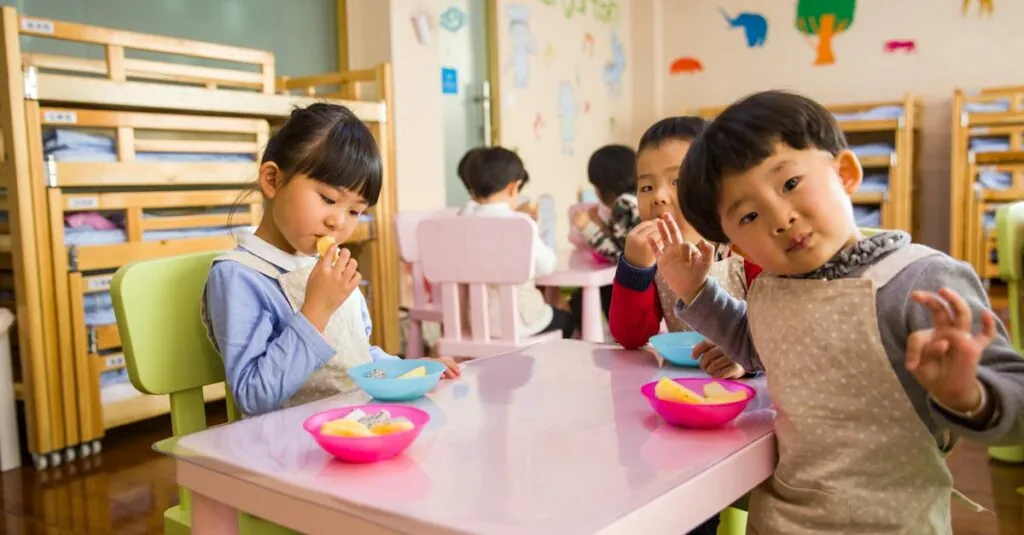Table of Contents
ToggleIn the delightful world of child development, parallel play is like the quirky cousin at a family reunion—often misunderstood but essential for growth. This stage of play, where kids engage in similar activities side by side without much interaction, might look like a scene from a silent film. But don’t let the quietness fool you; it’s a crucial stepping stone in social development.
Understanding Parallel Play
Parallel play represents a stage in child development where children engage in playside by side without direct communication. This stage plays a critical role in building social skills among young children.
Definition of Parallel Play
Parallel play typically occurs in early childhood, around 2 to 3 years of age. During this phase, children focus on their own activities while being aware of others in their vicinity. They may use similar toys and mimic actions without engaging in cooperative play. Understanding this stage helps caregivers recognize its significance in promoting independence and self-expression in children.
Characteristics of Parallel Play
Parallel play features several key traits that define its nature. Children often play near each other, yet their interactions remain limited. Equipment like blocks or dolls often occupies their attention, with each child absorbed in personal creations. Children observe each other’s actions, gaining inspiration for their own play while maintaining separate pursuits. This behavior aids in developing skills like sharing and turn-taking without the pressure of direct collaboration.
Stages of Child Development
Child development consists of various stages that are essential for social and emotional growth. Each stage plays a critical role in shaping interpersonal skills.
Importance of Play in Early Childhood
Play serves as a foundational component in early childhood development. Engaging in different types of play allows children to explore their environment. Improved motor skills develop through physical activities like running or climbing. Cognitive abilities receive stimulation from imaginative play scenarios. Children also practice emotional regulation while navigating social interactions during play. Incorporating diverse play experiences helps them build resilience and adaptability. Enhanced communication skills often emerge as children interact during playtime.
Developmental Stages and Parallel Play
Parallel play typically emerges between ages two and three. During this stage, children play side by side without direct interaction. Observing their peers allows them to learn social norms. Sharing space with others fosters a sense of community. Mimicking actions or behaviors is common as they engage with similar toys. This stage lays the groundwork for future cooperative play experiences. Understanding this phase aids caregivers in recognizing vital developmental milestones. Social skills evolve during parallel play, encouraging independence and individual expression.
Benefits of Parallel Play
Parallel play provides several developmental advantages for young children.
Social Skills Development
Social skills flourish during parallel play. Children observe peers, picking up cues about interaction and sharing. They notice how others react to certain behaviors, fostering empathy. While not engaging in direct play, kids develop an understanding of personal space and group dynamics. This exposure encourages them to engage more in cooperative play as they grow. Interactions during this stage become essential in teaching conflict resolution and turn-taking. Children often begin to mimic social gestures, building confidence in their social abilities. Ultimately, parallel play lays the groundwork for effective communication and collaboration in future interactions.
Cognitive and Emotional Growth
Cognitive skills enhance during parallel play. Engaging in individual activities alongside peers promotes problem-solving and creativity. As children explore similar toys, they examine different ways to approach play, leading to innovative thinking. Emotionally, parallel play nurtures self-regulation skills. Without direct competition or pressure, kids express their feelings freely while learning how to cope with frustration and joy. Additionally, these independent play moments promote concentration and focus, critical for cognitive development. Observing others in the play environment deepens emotional awareness and helps children recognize their feelings in relation to those of their peers.
Parallel Play vs. Other Types of Play
Parallel play stands as a unique form of interaction for children during their development. It occurs alongside various other types of play, each with distinct features that contribute to a child’s growth.
Comparing Parallel Play to Associative Play
Parallel play differs from associative play in several key aspects. While children in parallel play engage in similar activities without direct interaction, those in associative play exhibit a higher level of engagement. Children during associative play interact by sharing toys and making comments about each other’s actions. This increased interaction fosters collaboration and promotes communication skills. Observing peers during parallel play lays the groundwork for these interactions, highlighting how children can learn from one another even without direct involvement. Understanding these differences can enhance caregivers’ recognition of each play type’s developmental benefits.
Comparing Parallel Play to Cooperative Play
Cooperative play marks a significant advancement from parallel play. In cooperative play, children engage in shared goals and structured activities, emphasizing teamwork and collaboration. Unlike parallel play, where children play independently in proximity, cooperative play features organized play scenarios allowing children to work together more intentionally. During this stage, social skills such as negotiation and leadership flourish. As they transition from parallel play to cooperative play, children refine their ability to connect with others meaningfully. Each play type contributes uniquely to social development, demonstrating a child’s evolving capacity for interaction.
Encouraging Parallel Play in Children
Encouraging parallel play involves integrating specific activities and creating conducive environments. Fostering this play type enhances social and emotional development.
Activities That Promote Parallel Play
Offering children opportunities for parallel play helps strengthen their social skills. Toys like building blocks or art supplies inspire individual creativity, drawing children into similar pursuits. Craft stations enable kids to engage in activities side by side, observing and mimicking one another. Outdoor play areas featuring sandboxes or climbing structures promote natural parallel interactions. When children partake in these activities, they practice sharing space and resources while honing their observation skills.
Setting Up a Play Environment
Establishing a nurturing play environment is crucial for encouraging parallel play. Design spaces with clearly defined areas for various activities, such as a reading nook or sensory play zone. Each area should be stocked with similar toys, allowing children to engage alongside their peers. Utilizing low furniture creates an accessible atmosphere, fostering exploration and comfort. Every detail contributes to a supportive setting where parallel play can flourish, enabling children to interact indirectly while enjoying personal space.
Recognizing the significance of parallel play in child development is essential for caregivers and educators. This stage lays the groundwork for future social interactions and cooperative play. By allowing children to engage in parallel play, they can develop crucial social skills while fostering independence and emotional regulation.
Creating environments that encourage this type of play helps children learn to navigate social norms and build relationships. As they observe and share space with peers, they enhance their problem-solving abilities and creativity. Ultimately, parallel play is more than just a quiet activity; it’s a vital component of a child’s growth that shapes their ability to connect with others in meaningful ways.







